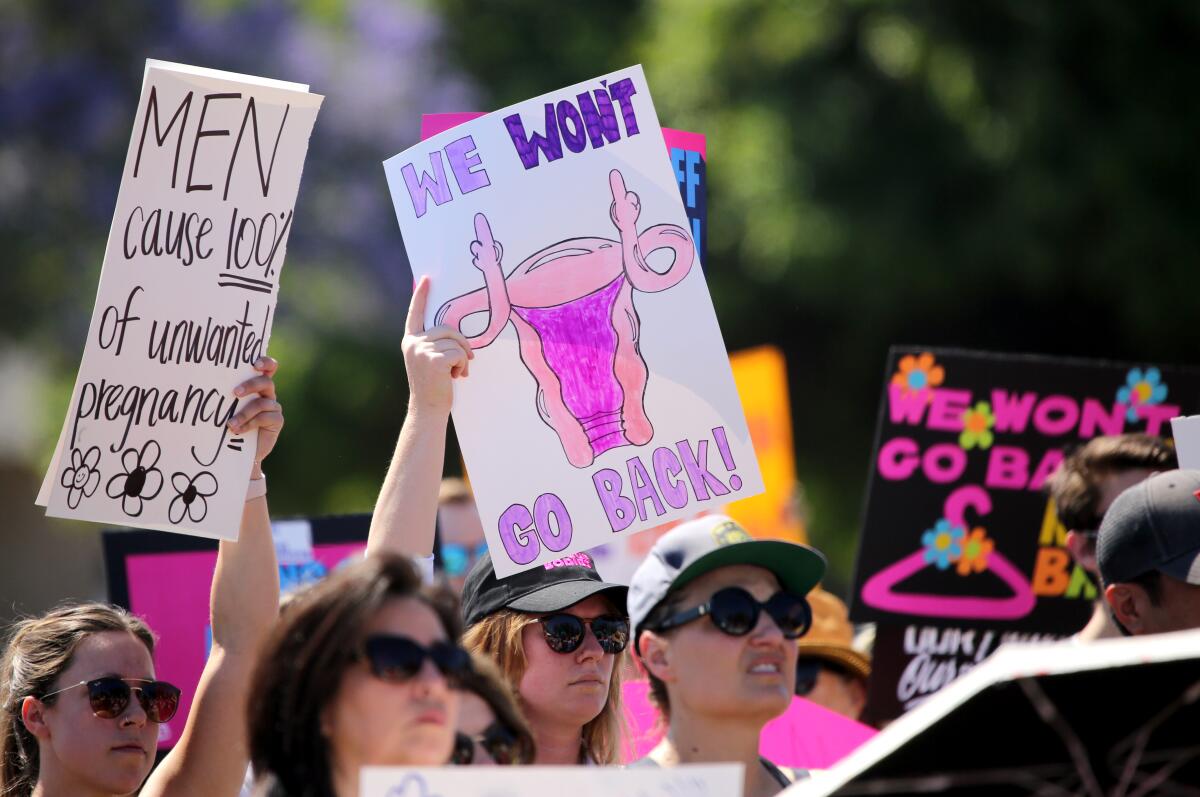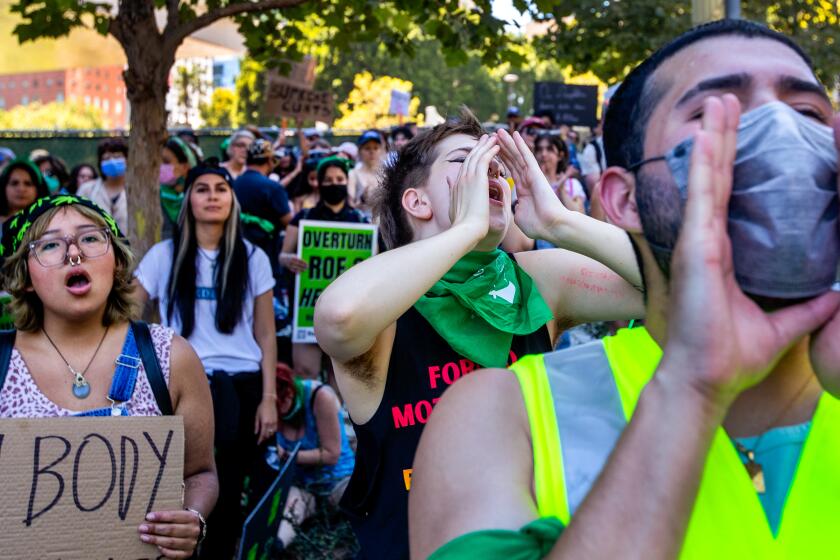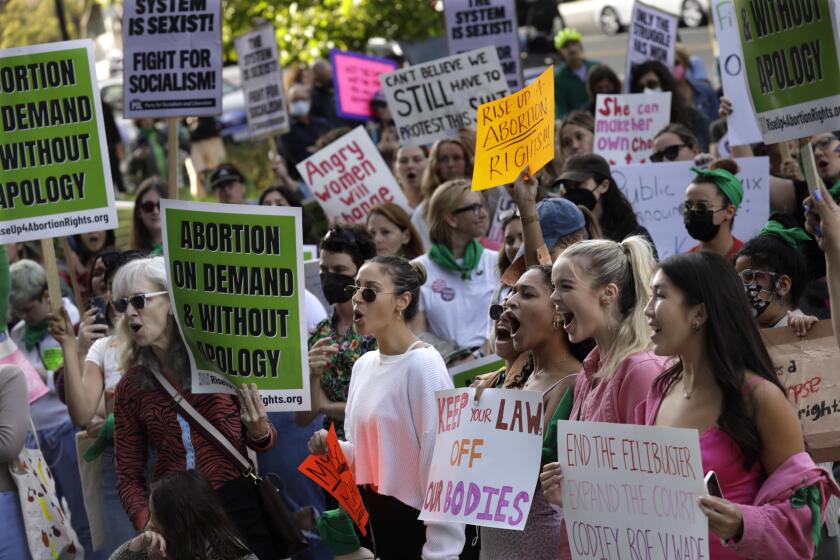Column: Would California’s abortion ballot measure allow late-term abortions? Its author says no

- Share via
SACRAMENTO — Based on a simple reading, Proposition 1 would seem to push California abortion law far left by allowing pregnancy termination right up until birth. Could that be correct?
No, that’s a false read, according to the legislation’s author and two law professors.
The measure on the November ballot merely cements into the state Constitution current law, they say.
But the language sure doesn’t read that way to most voters, I suspect. At least to those of us who aren’t lawyers.
It says the state cannot restrict abortion — any abortion — period.
Read for yourself:
“The state shall not deny or interfere with an individual’s reproductive freedom in their most intimate decisions, which includes their fundamental right to choose to have an abortion and their fundamental right to choose or refuse contraceptives.”
Another sentence states that the measure is “intended to further the constitutional right to privacy …and the constitutional right to not be denied equal protection.” Both have been interpreted to protect abortion rights.
The first sentence seems to be legalese for guaranteeing unrestricted late-term abortions.
Current law states that once a fetus is considered viable — able to survive outside the uterus without extraordinary medical measures — a woman can obtain an abortion only if continued pregnancy poses a significant risk to her health or life. Viability is around 23 weeks.
So-called partial birth abortions are illegal in California and throughout the United States.
But the proposition’s language seemingly would end current third trimester restrictions. And even if that’s convincingly refuted — more on that below — it has the potential of becoming a fall central campaign issue.
Proposition 1 is the primary response of California Democrats and abortion rights activists to the U.S. Supreme Court’s overturning Roe vs. Wade, the 1973 ruling that legalized pregnancy terminations nationwide. The court turned the issue over to states to determine their own abortion laws. And roughly half have eliminated or severely restricted abortion rights.
California has gone the opposite direction, spending more than $200 million to expand services and provide a sanctuary for abortion seekers from other states.
“I think they’ve overstepped,” asserts Ray McNally, strategist for the proposition’s opponents.
“It’s the most extreme abortion law you could put into the Constitution. There’s no limit on late-term abortion. They can occur at any time for any reason up to the moment of birth. Most Californians support some reasonable limits.”
State lawmakers approved a measure Monday that will ask California voters in November whether to enshrine abortion and contraceptives rights in the state Constitution.
He continues: “Down the road, it’ll be just one more instance when voters thought they were doing the right thing and they were hornswoggled. It fuels cynicism and bitterness and mistrust in government.”
The constitutional amendment’s author, state Senate leader Toni Atkins (D-San Diego), flatly denies that it changes current law regarding viability.
“The false narrative about ‘abortions up until birth’ are unscientific and created to politicize the conversation about abortion,” she said in a statement after the Legislature passed the measure mostly along party lines — Democrats for and Republicans against.
But during floor debates in both houses, queries about late-term abortions resulted in fuzzy replies. Basically, they were kissed off.
I called two law professors who specialize in abortion regulations, and both said that Proposition 1’s language isn’t the end of the story. There’s more than meets the eye. Constitutional amendments — whether federal or state — are subject to court interpretation, guided by legislative intent and precedent, they said.
“Generally speaking, constitutional language tends to be more aspirational — the language of principles and broad rights — with more detailed rules written in statutes,” said Loyola Law School professor Brietta Clark, an expert on healthcare law.
“Constitutional rights are never absolute. They always allow some restriction,” she continued. “What this constitutional amendment is doing is tracking language that has already been interpreted by the state Supreme Court in a way that absolutely allows some restriction.”
UCLA Law School professor Cary Franklin, faculty director of the Center on Reproductive Health, Law and Policy, agreed that “a constitutional right is not an absolute right. The state is going to be able to limit the abortion right.”
Here’s everything you need to know about the U.S. Supreme Court’s decision on Roe vs. Wade.
A prime example of a fundamental right being subject to restriction is the 2nd Amendment of the U.S. Constitution. It states that “the right of the people to keep and bear arms, shall not be infringed.” But even the current conservative Supreme Court agrees the 2nd Amendment allows for some gun restrictions.
“There’s a lot of fear mongering” on Proposition 1, Franklin said.
Mike Madrid, a Republican political consultant who specializes in Latino voter trends, told me that many Latinos may have a tough time accepting Proposition 1.
“Latinos are more anti-abortion than most groups,” he said. “They’re more Catholic than other groups.
“Most voters don’t support these extreme positions the pro-choice community advocates for,” he continued. “People overwhelmingly want abortion to be safe and rare, as Bill Clinton said. There is a side of the Democratic Party saying, ‘I can do whatever I want with my own body.’ That’s not where the public is.”
But he added: “I don’t think it will affect the outcome of the measure. It’ll affect how big the win is.”
Agreed — if there’s any effect at all. This is a deep blue state with a long history of supporting abortion rights.
Proposition 1 should be passed — for no other reason than to record California’s strong opposition to the overreaching Supreme Court decision.
But drafters should have made clear in the measure’s language that it was permissible to limit abortion after a fetus reaches viability.
More to Read
Sign up for Essential California
The most important California stories and recommendations in your inbox every morning.
You may occasionally receive promotional content from the Los Angeles Times.













